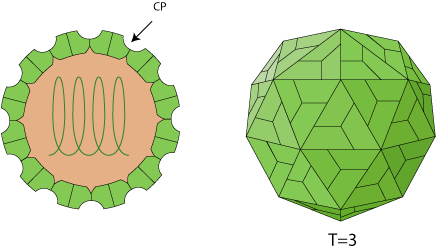Zeavirus (taxid:1299313)
VIRION

Non-enveloped, spherical, icosahedral, about 28-34 nm in diameter, capsid with a T=3 icosahedral symmetry. 30 hexameric capsomers per nucleocapsid (virion composed of 180 protein subunits).

GENOME
Monopartite, linear, ssRNA(+) genome of about 4 kb, which lacks a poly(A)tail. Has a 3? cap-independent translational enhancer (3?CITE).
GENE EXPRESSION
The virion RNA is infectious and serves as both the genome and viral messenger RNA. Two 5'-proximal ORFs are directly translated to produce the viral constituents of the replicase complex. RdRp is translated through suppression of termination at the end of ORF1. The downstream genes encoding the movement protein, viral suppressor of RNA silencing (VSR) and capsid proteins are translated from subgenomic RNAs.
Cap-independent translation is mediated possibly through the interaction between a 3'-cap-independent translation element and a 5'UTR stem-loop.
ENZYMES
REPLICATION
CYTOPLASMIC
- Virus penetrates into the host cell.
- Uncoating, and release of the viral genomic RNA into the cytoplasm.
- The viral RNA is translated to produce the two proteins necessary for RNA synthesis (replication and transcription).
- Replication takes place in cytoplasmic viral factories. A dsRNA genome is synthesized from the genomic ssRNA(+).
- The dsRNA genome is transcribed/replicated thereby providing viral mRNAs/new ssRNA(+) genomes.
- The RdRp recognizes internal subgenomic promoters on the negative-sense RNA to transcribe the 3'co-terminal subgenomic RNAs that will generate the capsid and movement protein.
- The RdRp recognizes internal subgenomic promoters on the negative-sense RNA to transcribe the 3'co-terminal subgenomic RNAs that will generate the capsid protein, movement protein and viral suppressor of RNA silencing (VSR).
- Virus assembly in the cytoplasm.
- Viral movement protein probably mediates virion cell-to-cell transfer.
